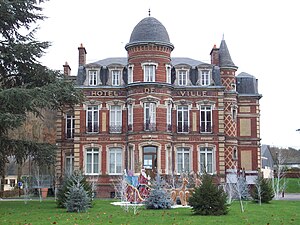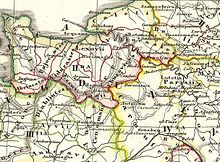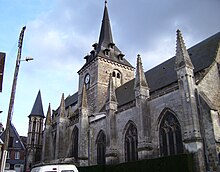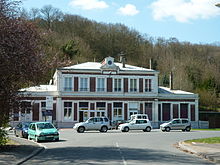Brionne
| Brionne | ||
|---|---|---|

|
|
|
| region | Normandy | |
| Department | Your | |
| Arrondissement | Bernay | |
| Canton | Brionne (main town) | |
| Community association | Intercom Bernay Terres de Normandie | |
| Coordinates | 49 ° 12 ' N , 0 ° 43' E | |
| height | 47-145 m | |
| surface | 16.77 km 2 | |
| Residents | 4,278 (January 1, 2017) | |
| Population density | 255 inhabitants / km 2 | |
| Post Code | 27800 | |
| INSEE code | 27116 | |
| Website | www.ville-brionne.fr | |
 town hall |
||
Brionne is a French town with 4278 inhabitants (at January 1, 2017) in the department of Eure in the region of Normandy .
geography
Brionne is located in the Risle Valley on the border between Roumois in the east and Lieuvin in the west, about 25 kilometers southeast of Pont-Audemer , 15 kilometers northeast of Bernay and about 14 kilometers north of Beaumont-le-Roger between the neighboring communities of Franqueville in the southwest, Calleville in the southeast, Bosrobert in the northeast and Brétigny in the northwest. In the south of the small town there is a 22 hectare lake.
history
Gallo-Roman time
The place already existed in Gallo-Roman times (52 BC to 486 AD) and was then called Breviodurum , which meant something like "bridge city". Brionne was then on the edge of the Civitas der Lexovii on the border with the Civitates of the Eburovices and the Veliocasses. Two Roman roads ran through the city . The bridge over the Risle was of great importance to trade. Breviodurum was therefore mentioned in the Itinerarium Antonini in 337 and is also shown on the Tabula Peutingeriana .
middle Ages
Duke Richard I. Fearless (935-996) gave Brionne as a county to his son Geoffroy de Brionne († around 1015).
Around 1050, a provincial council took place in Brionne , at which the heretic Berengar von Tours († 1088) discussed his theses with some monks from the Abbey of Le Bec .
In 1047 Gui de Brionne (also known as Gui de Bourgogne ) holed up in his castle in Brionne, which was then besieged by William the Conqueror . Gui was the leader of a rebellion by the barons against Wilhelm. Brionne fell and was handed over to Roger de Beaumont in 1090 .
The donjon was built by Robert I de Meulan towards the end of the 11th century , besieged by Henry I of England in 1124 and captured by Philip II of France in 1194 .
Philip IV (1268-1314) gave Brionne as a gift to Jean II. D'Harcourt .
During the Hundred Years War (1337-1453) the county changed hands several times. 1356 Brionne, while Jean VI. d'Harcourt († 1389) ruled there, besieged and taken by Henry of Grosmont . The French recaptured it, but lost it again after the Battle of Azincourt . It was freed again and returned to Jean VII d'Harcourt . After his death, Brionne fell by marriage to Antoine de Vaudémont (1400-1458).
Modern times
After an official Reformed church had been established in Rouen in 1557 and in Évreux in 1559 , Brionne followed this example with Authou . The Protestant church in Brionne / Authou did not exist until the 17th century. In 1562 Brionne was plundered and set on fire by the Protestants during the Huguenot Wars (1562–1598) , later Brionne was recaptured by the Holy League under Duc Charles I d'Aumale (1555–1631) and set on fire again and plundered.
In 1735 Louis II. De Lorraine, prince de Lambesc and comte de Brionne , had parts of the donjon destroyed. During the French Revolution (1789–1799) the ruins were declared a national property. In 1875 the historian Arthur Join-Lambert (1839-1917) bought the ruins to prevent the stones from being sold as building material.
The last seigneurial owner of Brionne before the French Revolution was Louise de Rohan-Guéménée († 1808 in Vienna ), the widow of Louis-Charles de Lorraine († 1761). Louise de Rohan received the Seigneurie after the death of her husband as a douaire ( widow things ). She organized the relief efforts in 1772 when a fire destroyed parts of the city center. The title Comte de Brionne was not carried from 1761 to 1789 by her, but by her son Charles-Eugène de Lorraine (1751-1825).
In 1793, during the French Revolution, Brionne received the status of a municipality and in 1801 the right to local self-government. In 1828 the hamlet of Valleville was incorporated.
In the summer of 1944 during World War II (1939-1945) Brionne was badly damaged. Many houses were destroyed, especially in the area around the Saint-Denis church, including the festival hall. The great bridge over the Risle was also bombed by the Allied Air Force on June 7, 1944 during Operation Overlord . On August 25, 1944, Brionne was liberated by the 2nd Canadian Corps (II Canadian Corps) .
| year | 1841 | 1866 | 1896 | 1931 | 1982 | 1990 | 1999 | 2006 | 2016 |
|---|---|---|---|---|---|---|---|---|---|
| Residents | 3,098 | 4.037 | 3,520 | 2,930 | 4,951 | 4,408 | 4,449 | 4,306 | 4,325 |
Brionne had the most inhabitants in 1982 (4951), from 1793 to 1841 the number of inhabitants doubled.
Culture and sights
Brionne is represented with a flower in the Conseil national des villes et villages fleuris (National Council of Flowered Cities and Villages). The "flowers" are awarded in the course of a regional competition, whereby a maximum of three flowers can be achieved.
Buildings
The donjon is a remnant of the castle of Brionne and dates from the 11th century. It is one of the few Norman square defense donjons. In 1925 it was entered in the supplementary directory of the Monuments historiques (historical monuments) and is classified with part of the slope as site classé (picturesque cultural monument).
Only ruins of the collegiate church of Sainte-Mère-de-Dieu remain, the Augustinian convent of the same name was dissolved by royal decree in 1735.
The Saint-Denis cemetery church dates from the Merovingian period (5th to 8th centuries) and is located on the former Roman road. It was used as a church until 1790. The cemetery belonging to it was used until 1860, but has been leveled today. During the Second World War (1944) the church was damaged by bombs and after its partial restoration it now serves as a gym. The church, the church square and the two trees on it are registered as site classé .
An original Saint-Martin church was built in the 11th century. During the sieges in 1090 and 1124 and a fire in 1183, the church was almost completely destroyed. Parts of the tower have been preserved. In 1356 the church was destroyed again in the Hundred Years War. After the conflagration of 1772, the church was restored and closed for seven years during the French Revolution. The tower of today's Saint-Martin church shows Romanesque and Gothic elements. The ground floor of the church is Romanesque, the part above is Gothic and the entrance door is from the 18th century. The high altar was designed in 1694 by Guillaume de la Tremblaye (1644–1715), an architect and monk, for the chapel de la Sainte-Vierge of the Abbey of Le Bec and only integrated into Saint-Martin after the French Revolution. Inside the church there is a stone statue of an apostle from the first half of the 15th century that was actually part of a collection of statues from Le Bec Abbey and the stone statue of Augustine of Canterbury from the first half of the 16th century that was also comes from the Abbey of Le Bec.
Town twinning
Since December 8, 1973 there has been a partnership with Shaftesbury in England and since October 8, 1983 a partnership with the German city of Lindlar .
Economy and Infrastructure
In the Middle Ages, wine was grown in Brionne . The street names Côte du Vigneron (vineyard slope ) and Chemin du Vigneron (vineyard path) on the slope of a wooded hill west of the D438 departmental road testify to this .
In 1803, Jean Le Marois (1776–1836), aide-de-camp of Napoleon Bonaparte , founded the first industrial weaving mill in Brionne. Other weaving mills followed and Brionne experienced an economic boom.
A mushroom farm is located in an old marl pit that was used as a bunker during World War II. There, oyster and shiitake grown.
Fruit is still grown, especially apples, but the production of cider and calvados in Brionne has declined since the 19th century. In the municipality there are controlled designations of origin (AOC) for Camembert (Camembert de Normandie) , Calvados and Pommeau (Pommeau de Normandie) as well as Protected Geographical Indications (IGP) for pork (Porc de Normandie) , poultry (Volailles de Normandie) and cider (cider) de Normandie and Cider normand) .
The former courthouse and prison now houses the music school. The old cells still exist in the basement.
traffic
The former covered market hall of Brionne originally belonged to the city's Comtes. It was confiscated during the French Revolution and sold to a dealer. In 1875 the city of Brionne bought it back and used the building as a town hall. In 1961, the building was demolished to facilitate traffic in the city center and to allow trucks to pass through.
Brionne station is served by the Caen - Rouen line of the SNCF . The original Rouen - Serquigny line opened in 1864.
The nearest airport is Rouen Airport (Aéroport Rouen Vallee de Seine) , 39.3 kilometers to the northeast.
Personalities
sons and daughters of the town
- Herluin (994-1078), also Hellouin , founded the Abbey of Le Bec
- Patrick Beaudouin (* 1953), French politician ( UMP )
Personalities who have worked on site
- Geoffroy de Brionne , († after 1023), according to Ordericus Vitalis (* 1075; † around 1142) first Count of Brionne , was possibly only lord of the castle there
- Arthur Join-Lambert (1839-1917), Norman historian, was conseiller général de l'Eure for the canton of Brionne for 50 years .
- Raphaël Collin (* 1850; † 1916 in Brionne), French painter and illustrator
- François Loncle (* 1941), French politician ( PS ), was Mayor of Brionne
literature
- Hervé Rotrou-Langrenay: Brionne et ses environs . Editions Alan Sutton, Joué-lès-Tours 1996, ISBN 2-910444-71-6 (French).
Web links
Individual evidence
- ↑ a b c Brionne on annuaire-mairie.fr (French) Retrieved February 11, 2010.
- ^ ALF Rivet: Celtic Names and Roman Places. Society for the Promotion of Roman Studies, 1980, p. I , accessed June 28, 2009 .
- ^ Dominique Cliquet: L'Eure . 27. In: Michel Provost, Academie des inscriptions et belles-lettres, Ministere de la culture (ed.): Carte Archéologique de la Gaule . Fondation Maison des Sciences de l'Homme, Paris 1993, ISBN 2-87754-018-9 , p. 45 (French).
- ^ A b Daniel Delattre, Emmanuel Delattre: L'Eure, les 675 communes . Editions Delattre, Grandvilliers 2000, pp. 56 f . (French).
- ^ Hans Friedrich Georg Julius Sudendorf, Berengar (of Tours): Berengarius Turonensis, or, A collection of letters concerning him . F. and A. Perthes, Hamburg 1850, p. 12-16, 28-30 ( in Google Books [accessed May 24, 2010]).
- ↑ Bernard Bodinier (ed.): L'Eure de la Préhistoire à nos jours . Jean-Michel Bordessoules, Saint-Jean-d'Angély 2001, ISBN 2-913471-28-5 , pp. 248 f . (French).
- ^ Franck Beaumont, Philippe Seydoux: Gentilhommières des pays de l'Eure . Editions de la Morande, Paris 1999, ISBN 2-902091-31-2 ( formally incorrect ) , p. 292 f . (French).
- ↑ a b c d e f Hervé Rotrou-Langrenay: Brionne et ses environs . S. 10 f., 13-15, 17-19, 28, 49, 53, 61 .
- ↑ a b Brionne on Cassini.ehess.fr (French) Retrieved November 3, 2009.
- ↑ A.-V. de Walle: Évreux et l'Eure pendant la guerre . Charles Herissey, Évreux 2000, ISBN 2-914417-05-5 , pp. 176, 181 (French, first published in 1946).
- ^ Raymond Ruffin: Le Prix de la Liberté . Juin - août 44th Presses de la Cité, 1995, ISBN 2-258-03893-6 , p. 266 .
- ^ Brionne, Palmarès des communes labellisées. (No longer available online.) Conseil National des Villes et Villages Fleuris, formerly the original ; Retrieved August 22, 2012 (French). ( Page no longer available , search in web archives ) Info: The link was automatically marked as defective. Please check the link according to the instructions and then remove this notice.
- ^ Brionne in Base Mérimée (French). Retrieved November 2, 2009.
- ↑ Guide de la vallée de la Risle et du pays d'Ouche . Charles Corlet, Condé-sur-Noireau 1984, ISBN 2-85480-084-2 , pp. 35-39 (French).
- ↑ Guillaume de La Tremblaye. In: arch INFORM .
- ↑ a b Brionne Tourist Office (French) Accessed August 22, 2012.
- ^ Brionne in Base Palissy (French) Retrieved November 2, 2009.
- ↑ À la découverte du shiitaké . paris-normandie.fr July 18, 2013.
- ↑ Halt ferroviaire de BRIONNE ( Memento of the original from September 2, 2012 in the Internet Archive ) Info: The archive link has been inserted automatically and has not yet been checked. Please check the original and archive link according to the instructions and then remove this notice. (French) Retrieved August 22, 2012.






